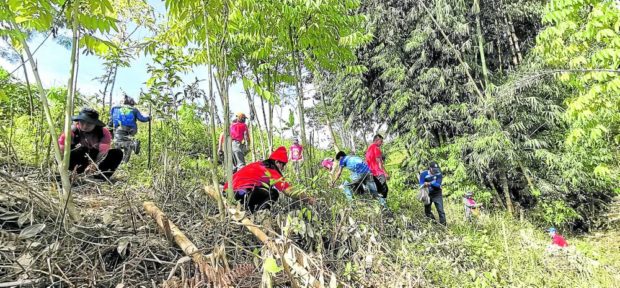
SUSTAINING WATERSHED Agrarian reform officials in Cotabato province along with local environment personnel plant trees around Asik-Asik Falls, Alamada town’s top tourist destination, to sustain its watershed. —PHOTO COURTESY OF DEPARTMENT OF AGRARIAN REFORM COTABATO
COTABATO CITY, Maguindanao del Norte, Philippines — Known for the water that gushes out along the side of the cliff to join a stream that serves as one of the headwaters of Cotabato province’s Libungan River, Asik-Asik Falls has been drawing tourists to the upland Cotabato town of Alamada each year.
This time, officials of the Department of Agrarian Reform (DAR) and of the municipal environment and natural resources office are joining local volunteers to plant trees around the waterfalls, both to protect the town’s top ecotourism destination and at the same time, cushion the impact of climate change.
“(We are planting trees) in support of the campaign to conserve the pristine beauty of one of the province’s tourist destinations, the Asik-Asik Falls,” said Charish Paña, provincial agrarian reform program officer, on Monday.
“With this initiative, we are helping our communities become more resilient at the same time, we protect the livelihood of our agrarian reform beneficiaries from the damage brought about by erratic weather conditions,” Paña said.
Concern
The DAR and the Alamada environment office plan to cover with fruit trees, bamboo, and indigenous trees the more than 15 hectares of mostly sloping land around Asik-Asik Falls.
Gina Escala, Alamada agrarian reform program officer, said they planted 100 bamboo propagules (“bayog”), 20 narra seedlings and 10 indigenous trees in the area on Nov. 18.
“This activity is one way to show our concern for the restoration and conservation of our environment and to restore the productivity of our natural resources, especially the lands covered by agrarian reform,” Escala said.
Danilo Puno, Alamada environment officer, said Mayor Jesus Sacdalan had issued an executive order requiring couples applying for marriage licenses to plant five fruit-bearing trees.
“We do not only plant, but we grow to ensure planted trees are nurtured, protected and sustained; especially with our tourist spots here,” Puno said.
“Asik-Asik” came from the Hiligaynon term for “sprinkle,” which was what locals named the waterfalls after they observed how its water sprinkled lush vegetation nearby, as it cascaded down several tiers of rocks.